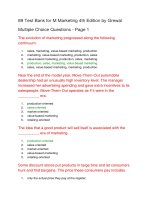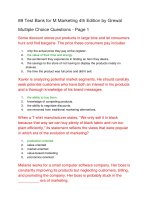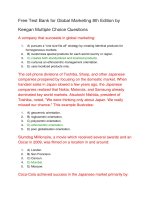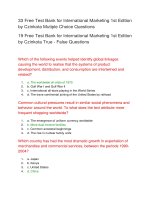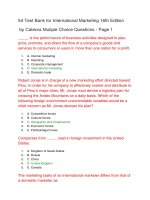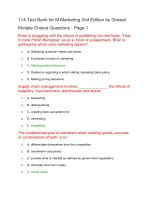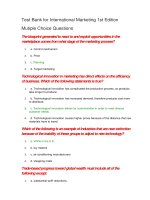Test bank for international marketing 17th edition by philip cateora john graham mary gilly
Bạn đang xem bản rút gọn của tài liệu. Xem và tải ngay bản đầy đủ của tài liệu tại đây (618.71 KB, 112 trang )
Test Bank for International Marketing 17th Edition by Philip
Cateora, John Graham, Mary Gilly
Chapter 03
History and Geography: The Foundations of Culture
True / False Questions
1. To understand fully a society's actions and its points of view, one must have an appreciation for
the influence of historical events.
True
False
2. Confucian philosophy, taught throughout Japan's history, emphasizes the basic virtue of loyalty to
the country.
True
False
3. A fundamental premise of Japanese ideology reflects the importance of individualism and
competitive spirit for economic progress.
True
False
3-1
4. Recording of historic events by historians belonging to different cultures gives us a subjective
view of history.
True
False
5. The Mexicans' attitude toward their American neighbors may be summed up in the statement—
"Geography has made us neighbors, tradition has made us friends."
True
False
6. In the context of U.S. foreign policies, the Monroe Doctrine, in its broadest interpretation, meant
that Americans were a chosen people ordained by God to create a model society.
True
False
7. In the context of U.S. foreign policies, the Monroe Doctrine was used to justify the U.S.
annexation of Texas, Oregon, New Mexico, and California.
True
False
8. In the context of U.S. foreign policies, the Monroe Doctrine dictated the abstention of the United
States from European political affairs.
True
False
9. In the context of U.S. foreign policies, the Roosevelt Corollary was an extension of the policy of
the Monroe Doctrine.
True
False
10. In the context of U.S. foreign policies, the Roosevelt Corollary paved the way for non-American
intervention in Latin American affairs.
True
False
3-2
11. The Roosevelt Corollary is typified by the dictum—whatever is good for the United States is
justifiable.
True
False
12. To understand a country's attitudes, prejudices, and fears, it is necessary to look beyond the
surface of current events to the inner subtleties of the country's entire past for clues.
True
False
13. Altitude, humidity, and temperature extremes are climatic features that affect the uses and
functions of products and equipment.
True
False
14. Physical barriers that exist within Europe are nowadays seen as a natural protection from
potentially hostile neighbors.
True
False
15. Countries that suffer the most from major natural calamities are among the poorest in the world.
True
False
16. In the context of social responsibility and environmental management, the United States
continues to be the world's top pollution-causing nation.
True
False
17. In the context of social responsibility and environmental management, the process of controlling
industrial wastes leads to the issue of disposal of hazardous waste, a by-product of pollution
controls.
True
False
3-3
18. In the context of social responsibility and environmental management, the Basel Convention
identified safe dumping zones for hazardous wastes exported by developed nations.
True
False
19. In the context of social responsibility and environmental management, the United States leads the
fight against pollution with the most stringent greenhouse emission standards in the world.
True
False
20. In the context of social responsibility and environmental management, sustainable development
is about protecting the environment at all costs.
True
False
21. In the context of social responsibility and environmental management, the idea of sustainable
development is quite popular in the United States owing to the cultural characteristics of the
Americans.
True
False
22. The availability of minerals and the ability to generate energy are the foundations of modern
technology.
True
False
23. In much of the underdeveloped world, human labor is the prevalent source of energy.
True
False
24. Petroleum's versatility ensures that petroleum-related products still dominate energy usage.
True
False
3-4
25. The United States is a major exporter of petroleum products.
True
False
26. China has emerged as the most efficient user of energy worldwide.
True
False
27. According to some economists, economic prosperity is a factor that leads to the decline in fertility
rates.
True
False
28. Most of the major industrialized countries have sufficient internal population growth to maintain
themselves.
True
False
29. North America is the region of the world most affected by a steadily declining worker-to-retiree
ratio.
True
False
30. Continuous improvements in electronic communications have facilitated the expansion of trade.
True
False
Multiple Choice Questions
3-5
31. Which of the following is true of culture?
A. It is a set of texts considered to be sacred.
B. It is a society's accepted basis for responding to external and internal events.
C. It is a branch of philosophy dealing with beauty and taste.
D. It is the philosophical study of being and knowing.
E. It is a set of written rules governing socially acceptable behavior.
32. In 1066, William the Conqueror defeated Harold II in the Battle of Hastings, establishing Norman
rule in _____.
A. Brazil
B. China
C. England
D. Japan
E. France
33. The _____ was a political protest against the British prohibition of Yankee traders from dealing
directly with merchants in Canton.
A. Hong Kong Revolution
B. Boston Tea Party
C. Taiping Rebellion
D. First Opium War
E. Canton Uprising
3-6
34. Which of the following commodities dominated the trade between Britain and China during the
early 1800s?
A. Bamboo
B. Mother-of-pearl
C. Silk
D. Tea
E. Porcelain
35. Which of the following commodities helped Britain erase the tea-caused trade deficit with China
during the 1800s?
A. Watches
B. Betel nuts
C. Diamonds
D. Textiles
E. Opium
36. Which of the following events caused the Chinese to cede Hong Kong to the British?
A. The First Opium War
B. The Satsuma Rebellion
C. The Tianjing Rebellion
D. The Taiping War
E. The Hong Kong Revolution
3-7
37. The opium wars resulted in a loss of confidence in the Chinese government. Which of the
following events was caused by the resulting disorder?
A. The Boxer Revolution
B. The Satsuma Rebellion
C. The Nanjing Rebellion
D. The Taiping Rebellion
E. The Hong Kong Revolution
38. Which of the following events is one of the pivotal factors behind the wariness of the Chinese
leadership toward foreign influences in general, and religious movements in particular, even
today?
A. The Boxer Revolution
B. The Satsuma Rebellion
C. The Nanjing Rebellion
D. The Hong Kong Revolution
E. The Taiping Rebellion
39. Which of the following events in the history of China has made the country wary of foreign
influences?
A. The Boxer Revolution
B. The Satsuma Rebellion
C. The Nanjing Rebellion
D. The Hong Kong Revolution
E. The Opium Wars
3-8
40. Which of the following is one of the tallest skyscrapers in Hong Kong today?
A. SunTrust Plaza
B. Jardine-Matheson Trading House
C. Vision Tower
D. Comcast Center
E. Aspire Tower
41. Japan was an isolated country before the arrival of _____ in 1853.
A. Marco Polo
B. Admiral Halsey
C. Commodore Perry
D. Admiral Pennington
E. The East India Company
42. Which of the following may best explain why the Japanese have such strong loyalty toward their
companies?
A. Zen philosophy
B. Taoism
C. Confucian philosophy
D. Buddhism
E. Bushido philosophy
3-9
43. Which of the following events occurred during the Mexican Revolution?
A. The overthrowing of dictator Ernesto Zedillo
B. The youth movement against religion
C. The nationalization of Mexican oil industry
D. The expulsion of North American businessmen
E. The support of French arms for revolutionaries
44. In the context of the Mexican-American War, the president of Mexico, the cabinet, and the
diplomatic corps assemble at the Mexico City fortress every September 13 to recall the defeat
that led to the _____.
A. "despojo territorial"
B. "la pérdida de comercio"
C. "destrucción de la propiedad"
D. "soldados mutilados"
E. "los niños sin hogar"
45. Which of the following events, leading to the overthrowing of the dictator D'az, is particularly
remembered for the expulsion of foreigners—most notably North American businessmen who
were the most visible of the wealthy and influential entrepreneurs?
A. The Madero Rebellion
B. The Mexican Revolution
C. The Los Niños Rebellion
D. The Mexican-American War
E. The San Patricios Revolution
3-10
46. In 1450, the _____ was the first book printed with movable type.
A. Iliad
B. Gutenberg Bible
C. Codex Manesse
D. Scriptorium
E. Odyssey
47. Which of the following statements most accurately reflects the feelings of most Mexicans toward
the United States?
A. Mexicans trust and favor the United States above other trading partners.
B. Mexicans prefer Europeans over the United States with respect to trade.
C. Mexico considers the United States a protector who will help it emerge as a world power.
D. Mexicans see the United States as a threat to their political, economic, and cultural
independence.
E. Mexicans see the United States as a land of abundant opportunity and good fortune.
48. In 1531, _____ stock exchange was the first exchange to move into its own building, signifying its
importance in financing commercial enterprises throughout Europe.
A. Bruges
B. Amsterdam
C. Frankfurt
D. Antwerp
E. Berliner Borse
3-11
49. In 1561, _____ came to Europe from the Near East, via the Dutch traders, for the first time.
A. tulips
B. roses
C. chrysanthemums
D. sunflowers
E. carnations
50. In 1425, the Hanseatic city of _____ became the first Atlantic seaport to be a major trading
center.
A. Bastogne
B. Lubeck
C. Brugge
D. Mons
E. Cologne
51. What was the overall end result of the Mexican War of 1846-1848?
A. Mexico was forced to cede California to the U.S.
B. The U.S. and Mexico signed a non-aggression pact.
C. Mexico gave up California and the U.S. gave up Baja California.
D. Mexico paid the U.S. $5 million for war damages.
E. The U.S. signed a pledge to not invade Mexico again.
3-12
52. The idea of Manifest Destiny was used to justify the U.S. annexation of _____.
A. Virginia
B. Ohio
C. Pennsylvania
D. California
E. Carolina
53. In 1464, the French royal mail service was established by _____.
A. Clovis I
B. Napoleon III
C. Childeric I
D. Childebert I
E. Louis XI
54. Manifest Destiny and the _____ were accepted as the basis for U.S. foreign policy during much of
the 19th and 20th centuries.
A. Roosevelt Corollary
B. North American Security Treaty
C. Monroe Doctrine
D. Grant Mandate
E. Hays Corollary
3-13
55. In 1600, _____ were brought from South America to Europe, where they quickly spread to the rest
of world and become a staple of agricultural production.
A. tomatoes
B. potatoes
C. shallots
D. peanuts
E. eggplants
56. In the context of U.S. foreign policy in the 19th and the 20th centuries, _____, in its broadest
interpretation, meant that Americans were a chosen people ordained by God to create a model
society.
A. Roosevelt Corollary
B. Monroe Doctrine
C. Hays Corollary
D. Grant Mandate
E. Manifest Destiny
57. The Manifest Destiny specifically referred to the:
A. political clout of the United States over European countries.
B. territorial expansion of the United States from the Atlantic to the Pacific.
C. focus on investment and infrastructure development in Asia-Pacific.
D. network of intelligence operations across the world, especially the Communist world.
E. "white man's burden" to develop the underdeveloped parts of the world.
3-14
58. In 1600, Japan began trading _____ for foreign goods.
A. diamonds
B. gold
C. platinum
D. copper
E. silver
59. Abstention of the United States from European political affairs was one of the three basic dicta of
the _____.
A. Monroe Doctrine
B. North American Security Treaty
C. Hays Corollary
D. Grant Mandate
E. Roosevelt Corollary
60. Which of the following policies was used in the formation of a provisional government in Cuba in
1906?
A. The Manifest Destiny
B. The Hay Manifesto
C. The Wilson Mandate
D. The Roosevelt Corollary
E. The Gadsden Policy Position
3-15
61. The _____, a cornerstone of early U.S. foreign policy, dictated that no further European
colonization in the New World would be accepted.
A. Madison Corollary
B. Monroe Doctrine
C. Hays Corollary
D. Wilson Policy Position
E. Manifest Destiny
62. Which of the following U.S. foreign policies was applied in 1905 when the Dominican Republic
was forced to accept the appointment of an American economic adviser?
A. The Manifest Destiny
B. The Hay Manifesto
C. The Wilson Mandate
D. The Gadsden Policy Position
E. The Roosevelt Corollary
63. The United States' acquisition of the Panama Canal Zone best exemplifies the _____.
A. Manifest Destiny
B. Hay Manifesto
C. Roosevelt Corollary
D. Gadsden Policy Position
E. Wilson Mandate
3-16
64. _____ is the study of the earth's surface, climate, continents, countries, peoples, industries, and
resources.
A. Geophysics
B. Geography
C. Cartography
D. Demography
E. Remote sensing
65. _____ includes an understanding of how a society's culture and economy are affected as a nation
struggles to supply its people's needs within the limits imposed by its physical makeup.
A. Remote sensing
B. Geography
C. Cartography
D. Demography
E. Geomatics
66. Which of the following best describes the current perception of geographical features such as
mountains in the context of economic growth in Europe?
A. They provide natural protection from potentially hostile neighbors.
B. They are impediments to efficient trade and communication.
C. They are natural landmarks that symbolize national treasure.
D. They are fortuitous blessings that provide a wealth of natural resources.
E. They are symbols of national heritage and history.
3-17
67. In the context of social responsibility and environmental management, which of the following is a
by-product of pollution controls?
A. Corporate environmental responsibility
B. Higher tariffs against developing countries
C. The disposal of hazardous waste
D. Reduced availability of petroleum products
E. The emission of greenhouse gases
68. Which of the following countries is the world's top polluter, at present, in almost all respects?
A. Brazil
B. China
C. Sudan
D. Afghanistan
E. Zimbabwe
69. Which of the following treaties was revised to include a total ban on the export of hazardous
wastes by developed nations?
A. Treaty of Lisbon
B. The Basel Convention
C. The North American Free Trade Agreement
D. ASEAN charter
E. St. Andrews agreement
3-18
70. _____ development is a joint approach among those who seek economic growth with "wise
resource management, equitable distribution of benefits and reduction of negative effects on
people and the environment from the process of economic growth."
A. Parallel
B. Global
C. Sustainable
D. Unrestricted
E. Holistic
71. Which of the following sources of energy provides the preponderance of energy in much of the
underdeveloped world?
A. Nuclear power
B. Human labor
C. Wind energy
D. Geothermal power
E. Fossil fuel
72. Which of the following sources of energy dominates the world's energy usage?
A. Hydroelectric power
B. Petroleum products
C. Wind energy
D. Geothermal power
E. Nuclear power
3-19
73. Which of the following best explains why petroleum-related products continue to dominate energy
usage?
A. It is easy to store and transport.
B. Most governments do not favor alternate energy sources.
C. It is still the cheapest form of fuel.
D. Petroleum products remain the most efficient forms of fuel.
E. The reserves of petroleum are unlimited.
74. Which of the following statements is true about the consumption of petroleum products by the
United States?
A. America is the largest producer of petroleum products.
B. America is likely to stay self-sufficient for the next several decades.
C. America is the third largest consumer of petroleum products.
D. America has become a major importer of petroleum products.
E. Petroleum products are no longer the largest source of energy for the U.S.
75. Which of the following countries is considered to be the world's most efficient user of energy?
A. Canada
B. Vietnam
C. Japan
D. India
E. China
3-20
76. Which of the following countries has an inefficient oil usage pattern chiefly due to outdated
technology?
A. Africa
B. Latin America
C. China
D. North America
E. Japan
77. Which of the following sources of energy has a greater emphasis in North America?
A. Animal wastes
B. Natural gas
C. Coal
D. Oil
E. Wood
78. Which of the following is true with respect to the dynamics of global population trends?
A. The demand for goods worldwide may have no effect on migration patterns.
B. Changes in the distribution of population among the world's countries may fail to influence
demand.
C. The global financial crisis has caused migration from rural to urban areas within countries.
D. Economic growth forecasts and assumptions about fertility rates are independent of each
other.
E. The existence of sheer numbers of people is significant in appraising potential consumer
markets.
3-21
79. Which of the following statements is true with respect to the economic effects of controlling
population growth?
A. Fertility rates increase proportionately to the rate of economic growth.
B. A decline in fertility rate is a function of economic prosperity.
C. Lower male-female ratios favor higher fertility rates.
D. Developing nations tend to have lower fertility compared to developed nations.
E. Higher population growth rates have resulted in increased global trade.
80. Which of the following is true of the industrialized world's population?
A. It is increasing at an unprecedented pace.
B. It is in decline and rapidly aging.
C. It mainly consists of young adults.
D. It is similar to the population of developing countries.
E. It has remained constant for a long time.
81. The part of the world with the largest portion of people over 65 years is also the part of the world
with the fewest number of people under age 15 years. Which of the following is most likely to be a
possible result of this disparity?
A. A conscious effort to slow down rapid urbanization and industrialization.
B. A larger focus on automation and technology in industries.
C. A heavy tax burden on future workers.
D. An increased focus on lower birth rates through incentives.
E. An increase in migration to other nations.
3-22
82. Which of the following factors will ameliorate explosive population expansion in less developed
countries?
A. Stable worker-to-retiree ratio
B. Free flow of immigration
C. Better senior retirement programs
D. Prenatal sex scanning
E. Provisions for higher pension
83. Which of the following is the most universal means used by governments to control birth rates?
A. Family planning
B. Universal access to healthcare
C. High literacy levels
D. Education for women
E. Improved nutrition
84. Which of the following is considered to be the most important deterrent to population control?
A. Financial benefits of having large families
B. Poor enforcement mechanism
C. Lack of awareness about population trends
D. Government welfare schemes for orphans
E. Cultural attitudes that favor large families
3-23
85. In the context of global population trends, a nation needs a fertility rate of about 2.1 children per
woman to be able to:
A. reduce its population.
B. maintain its population.
C. encourage immigration.
D. increase its population.
E. discourage immigration.
86. Which of the following regions of the world is most affected by aging and thus by a steadily
decreasing worker-to-retiree ratio?
A. Africa
B. North America
C. South America
D. Asia
E. Europe
87. Countries like _____ and the U.S. epitomize the problems caused by an increasing percentage of
elderly people who must be supported by a declining number of skilled workers.
A. Brazil
B. China
C. Egypt
D. Chile
E. Japan
3-24
88. _____ represent(s) the attempts of countries to overcome economic and social imbalances
created in part by the influence of geography.
A. Import tariffs
B. Free Trade policies
C. Trade routes
D. Global migration
E. Resource sharing pacts
89. Which of the following was the earliest trade route?
A. Land routes
B. The Internet
C. Sea routes
D. Underground routes
E. Air routes
90. An underpinning of all commerce is _____—knowledge of where goods and services exist and
where they are needed.
A. sustainable development
B. expropriation
C. immigration
D. effective communications
E. political stability
Essay Questions
3-25

